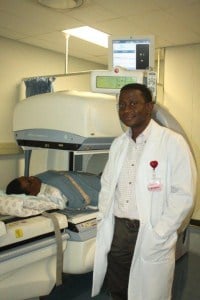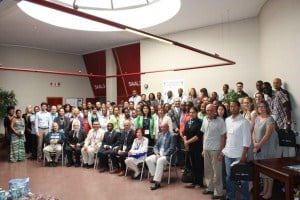Posted on April 12, 2013
The University of Pretoria is the first institution in Africa to host the international ISORBE Congress, which aimed to educate both local nuclear medical practitioners and those from elsewhere in Africa on new developments in their field. As an institution that offers training to specialists in the field of nuclear medicine, as recommended by the International Atomic Energy Agency (IAEA), the University of Pretoria is highly regarded on the continent.
The speakers covered a wide range of updates regarding the imaging and management of conditions involving infections and inflammation that occur in the case of, for instance, vascular grafts, prosthetic joints, diabetic feet, inflammatory bowel disease (IBD), neuro-inflammation, sacoidosis, tuberculosis, atherosclerosis, gastrointestinal tract (GIT) infections and apoptosis. Presentations were also given on the most recent developments and research in the field of radio-labelled cells, including stem cells, dendritic cells and natural killer (NK) cells, and novel techniques such as Galium-68 labelled peptides and Tc-99m-UBI.
The topic of Prof Sathekge’s presentation was the utilisation of 18F-FDG positron emission tomography (PET) scans to predict the effectiveness of treatment for multidrug-resistant (MDR) tuberculosis in HIV patients. He demonstrated how PET scans can be used to determine at an earlier stage whether treatment for tuberculosis is effective, or whether a patient is multidrug-resistant.
The attendance of the OSORBE Congress was outstanding and Prof Sathekge said that South Africa had benefitted from the excellent scientific programmes presented by various reputable researchers in the field of nuclear medicine and the subsequent discussions and resolutions, especially with regard to the problem of infectious diseases, which seems to be a problem in this country.
Prof Mike Sathekge has presented papers in several countries and served on the Board of Directors of the ISORBE on account of his impressive contribution and sterling research in the field of nuclear medicine. However, at the recent ISORBE Congress at the University of Pretoria, Prof Sathekge was unanimously elected as the new president of the Society. He will replace Turkey’s Prof Kutlan Ozker, a specialist in the field of nuclear medicine, who had voluntarily resigned and had nominated Prof Sathekge as his successor. This nomination was seconded by the majority of the executive members as well as the Board.
Regarding his appointment as the new president, Prof Sathekge said that he was humbled by having been elected and that he regarded it as a great honour. He said that he was stepping into the shoes of past presidents who are not only prominent and reputable researchers who have published numerous scientific papers, but who have also discovered a new labelling for blood elements. He said that he was looking forward to new ground-breaking research during his tenure as president and promised to steer the Society in the right direction and make a notable contribution in terms of research.
Following his appointment, Prof Sathekge opted to resign as the national chairperson of the South African Medical Association’s (SAMA) Education, Science and Technology Division. During his term at SAMA, Prof Sathekge initiated PhD funding/scholarships to encourage research by young medical clinicians in the country. The scholarships are awarded to two medical doctors biennially. ‘I identified a need to establish a scholarship so as to assist physicians since they often do not continue to pursue their PhDs. This scholarship assistance by SAMA addresses the shortage of clinical research in the country and shows the profession investing in itself,’ he said.
Prof Sathekge is also the president of the College of Nuclear Physicians in South Africa, which is the examining body for all the nuclear medicine specialists in the country.
The former president of ISORBE, Prof Kutlan Ozker, described Prof Sathekge as one of the leading physicians in the area of infection and inflammation imaging who is not only an outstanding physician, but also one of the rare scientists in the global nuclear medicine community. ‘His contributions in this dynamic field are not limited to infection and inflammation imaging. He has initiated novel techniques and has introduced very valuable methodologies and new radiopharmaceuticals in nuclear medicine. There is no doubt in our minds, as the ISOBRE presidium, that we are very fortunate to have him as our president.’
Prof Ozker further acknowledged the good output of the Department of Nuclear Medicine at the University of Pretoria in respect of TB and HIV. He mentioned the developments already made by the Department and said that he was looking forward to seeing them taking further steps towards developing new radio-pharmaceuticals for the treatment of tuberculosis (TB). According to him, ‘the University of Pretoria is the centre most likely to develop new tracers for specific new strains of TB’.
Prof Matthew Thakur, the founding president of ISORBE, which is based in Philadelphia, USA, also acknowledged the contribution made by the University of Pretoria’s Department of Nuclear Medicine to the radio-labelling of blood cells. He said: ‘I am looking forward to Prof Sathekge’s labelling white blood cells and taking it further to stem-cell labelling using gallium-68 (g-68)’. Prof Sathekge replied that although this would be difficult to achieve, he viewed it as a challenge his Department would be willing to accept.
At its previous conference the ISORBE resolved to continue to hold informative conferences and also to offer courses in the radio-labelling of white blood cells and the labelling of new radio-pharmaceuticals. Another resolution was to increase collaboration between different centres and to revive the writing of position papers on infection imaging.
Who is Mike Sathekge?
Mike Sathekge grew up in Tembisa, east of Johannesburg. He later attended the former Central Secondary State School in Soshanguve, Pretoria, where he matriculated in 1987, achieving the highest marks in the country (99%) in Mathematics. Although he had been accepted to study Mechanical Engineering at the University of Witwatersrand in 1988, his family persuaded him to study medicine and he was subsequently accepted as a student at Medical University of South Africa (MEDUNSA), from where he graduated in 1993.
During his registrar period he received a scholarship to attend the Catholic University in Leuven, Belgium as a research fellow, but later moved to Ghent University, also in Belgium, where he completed his PhD in Nuclear Medicine (specialising in molecular imaging in TB and HIV).
Although he is widely known in international medical circles as a nuclear medicine physician for TB and HIV, he also investigates other therapeutic roles of nuclear medicine.
He has pioneered a special new procedure to remove cancerous liver tumours without surgery in South Africa. This procedure, known as Selective Internal Radiation Therapy (SIRT), uses the SIR-spheres’ microspheres (yttrium-90 resin microspheres) as an innovative form of internal radiotherapy for removing liver cancers. The yttrium-90 resin microspheres are inserted through the hepatic artery that feeds the vessel of the tumour. This goes directly to the affected area and dissolves or reduces the size of the cancerous tumour without damaging the tissue surrounding the liver. This form of liver radiotherapy has been used successfully in the treatment of patients with different forms of inoperable liver tumours. Recently peptide radionuclide therapy for the treatment of neuro-endocrine tumours has also been introduced in South Africa and Africa.
Prof Sathekge started his career as Head of the Department of Nuclear Medicine at MEDUNSA and was appointed in the same position at the University of Pretoria in 2005.
He is married to Dr Rachel Sathekge, an orthodontist. The couple has two sons.

Prof Sathekge with a patient in the Single-photon emission computed tomography (SPECT/CT) Room, which is a nuclear medicine tomographic device used to detect various diseases in their early stages.

Local and international delagates attending the 16th Conference of the International Society of Radiolabelled Blood Elements (ISORBE), hosted by the University of Pretoria.
Copyright © University of Pretoria 2025. All rights reserved.
Get Social With Us
Download the UP Mobile App